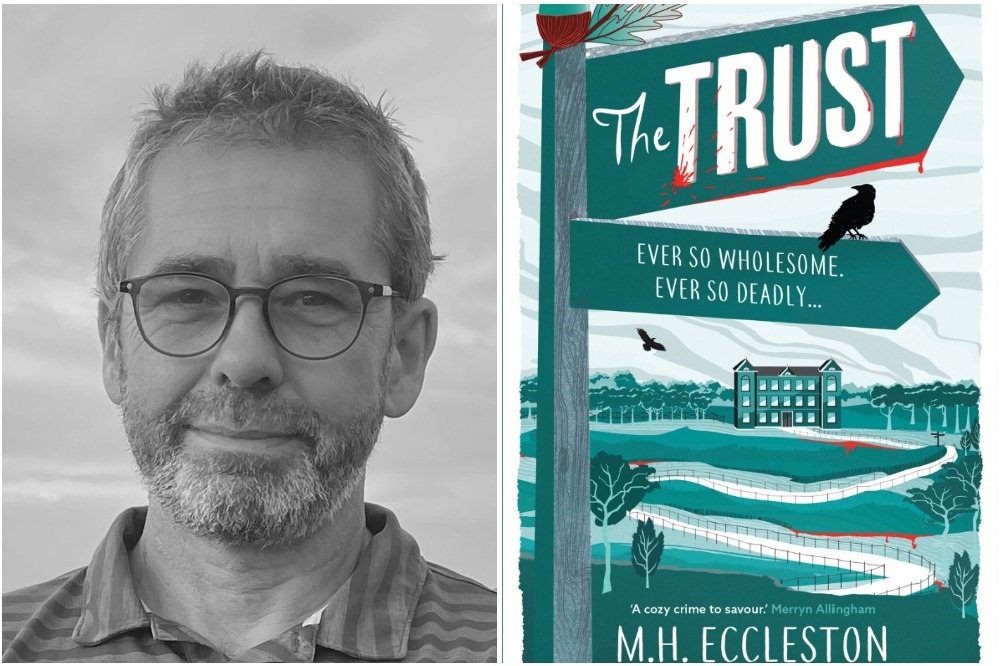Everyone who writes whodunnits is looking for an amateur detective with a unique set of skills. Literary crimes are more fun when they’re solved by gardeners, vicars, magicians and chefs. I waited a long time for art conservator Astrid Swift to turn up and start solving crimes.

M H Eccleston, The Trust
It started with an image of a woman crying in a shower. Close on her face, it’s hard to tell that’s what’s happening. The water from the showerhead disguises her tears. Then she switches off the shower – she’s seen something, thought about something maybe, that’s made her distraught. That’s as far as I got. I couldn’t see a way of putting it into a story, and the image floated around in my head with the rest of the jetsam. Until I worked out why she was crying.
She’s seen a glint of gold in the plughole – it’s a bracelet… and it’s not hers. Which means her husband has been unfaithful. That’s pretty much how The Trust starts as Astrid realises that her husband has cheated on her, and her life will never be the same. It’s her reaction to the discovery that was the breakthrough in creating, I hope, a brand-new amateur detective.
Astrid dresses, goes through to another room and opens a black work case. Then she takes out an acid-test square – a small black tile that’s used to establish the purity of gold. In this case, the bracelet. Elsewhere in the work case are solvents, paints, tools and scalpels. Everything that you might need as both an art conservator and a forensic expert.
Art conservators, from what I can see, would make great detectives. They’re methodical and patient, often spending weeks, months even, painstakingly cleaning and repairing paintings. They’re highly qualified too – usually with degrees in science or the history of art. Sometimes both. Astrid’s knowledge of chemistry serves her well when she discovers her first body. An unlucky antiques dealer has fallen to his doom at the bottom of an icehouse in the stately home in Dorset, where she’s now living. Her enquiring mind is now applied to solve the case. Slowly, like repairing a painting, peeling back the layers, a clearer picture begins to emerge.
Throughout the series – The Trust is the first instalment of three – Astrid is never far from her battered work case. Inside are the tools of her trade that will come in handy when she’s investigating clues and crime scenes. She can collect the smallest of samples. Perform chemical tests. Magnify fingerprints under a UV lamp. Later in the series, her knowledge of which pigments and paints fluoresce under UV will come in very handy.
One of the beautiful tools in her work case is called a ‘bone folder.’ It’s a slim blade of polished cattle bone. Book conservators use it to separate pages and create crisp, new folds. In the wrong hands it could be used as a deadly weapon. And the name – ‘bone folder’, has a deadly ring to it. At one point that was going to be the title of the second book. But it was a bit grisly. The series is on the cosier end of crime fiction.
Astrid also has an artist’s eye for detail. Having spent a career poring over paintings, she spots things that other people don’t. Not least the local police – and the local police in whodunnits never get it right, do they? If they did, I guess there would be no need for the amateur detectives. Then there’s her lack of squeamishness. Poring over fine art – the serene alabaster bodies in Renaissance paintings – makes finding a body in real life less of a shock. Astrid has lots of skills, but there are many things she’s hopeless at. A lot of flaws. She’s a bit of a snob, at the start of the book at least. She drinks too much – red wine, usually. And she’s stubborn and nosey. But she’s tough and never gives in. Whatever happens to her – at work and in her private life – she sets out to find the solution without feeling sorry for herself. I hope she gives art conservators a good name.
The Trust is out in paperback on the 28th of April and is published by Head of Zeus. Mark can be found on Twitter @MarkEccleston1


